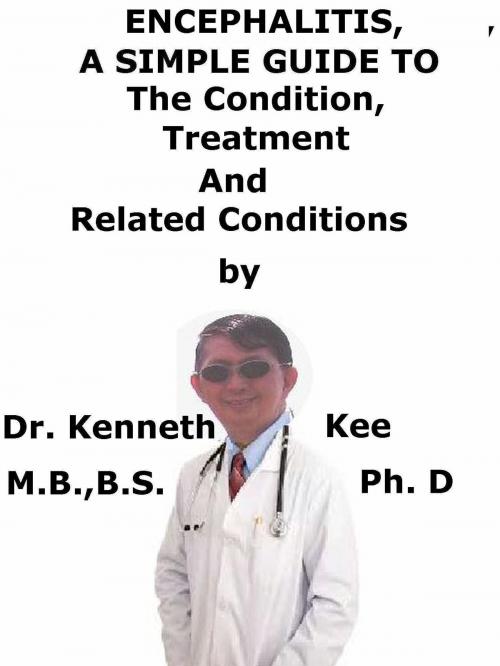Encephalitis, A Simple Guide To The Condition, Treatment And Related Conditions
Nonfiction, Health & Well Being, Medical, Ailments & Diseases, Infectious Diseases, General, Health, Nervous System & the Brain| Author: | Kenneth Kee | ISBN: | 9781370497744 |
| Publisher: | Kenneth Kee | Publication: | October 21, 2016 |
| Imprint: | Smashwords Edition | Language: | English |
| Author: | Kenneth Kee |
| ISBN: | 9781370497744 |
| Publisher: | Kenneth Kee |
| Publication: | October 21, 2016 |
| Imprint: | Smashwords Edition |
| Language: | English |
Encephalitis is a serious medical disease which causes inflammation and infection of the brain.
The causes of Encephalitis may be divided into:
1. Viral infections are the most common
(Herpes simplex, virus, mumps, West Nile Encephalitis, Japanese Encephalitis, St Louis Encephalitis).
Of these viruses, herpes simplex virus is the most serious and can cause fatality.
2. Bacterial infections such as meningococcal (Neisseria meningitidis) and pneumococcus (Streptococcus pneumoniae) can be serious and fatal in some cases.
Meningococcal Encephalitis can cause outbreaks (spread easily).
3. Fungi,
Cryptococcus neoformans is the most common cause of fungal Encephalitis
4. Parasitic
Examples are Toxoplasmosis, malaria, amoeba, Lyme disease
The symptoms which often define Encephalitis are:
1. Severe headache
2. Fever
3. Confusion
4. Drowsiness
5. Fatigue
6. Seizures
7. Convulsions
8. Hallucinations
9. Memory problems
10. Tremors
11. Weakness of the hands and legs
12. Incontinence of urinary and bowel movement
Diagnosis of Encephalitis is based on:
1. Typical symptoms of fever, headache, confusion.
2. Physical examination shows confusion, drowsiness and signs of neck rigidity
3. Blood tests (full blood count, ESR and blood culture)
4. Cerebrospinal fluid analysis (CSF) via lumbar puncture is examined for increased white blood cells and protein content, normal glucose level.
Red blood cells may be present if there is bleeding. Sometimes the CSF may show the presence of micro-organisms.
This test should not be done if there is suspected cerebral mass lesion or raised intracranial pressure (head injury, localizing neurological signs, or signs of raised ICP).
5. CT or MRI of the brain and spine with MRI preferred over CT because it can detect more easily areas of cerebral edema, tumors, ischemia and meningeal inflammation.
Treatment of Encephalitis is by:
1. Hospitalization should be immediate as Encephalitis is a life threatening condition.
2. Antibiotics such as cephalosporin, ampicillin, chloramphenicol, intravenous vancomycin to be started even before doing lumbar puncture.
Acyclovir may be given for herpes virus infection
High dosages of antifungals may be given for Fungal Encephalitis for a prolonged period of time
3. Corticosteroids is useful to reduce swelling and inflammation in the brain
4. Sedatives may be needed for irritability and restlessness
5. High-flow oxygen
6. Intravenous fluids
TABLE OF CONTENT
Introduction
Chapter 1 Encephalitis
Chapter 2 More Facts of Encephalitis
Chapter 3 Treatment of Encephalitis
Chapter 4 Meningitis
Chapter 5 Yellow fever
Chapter 6 Cryptococcosis
Chapter 7 Epilepsy
Epilogue
Encephalitis is a serious medical disease which causes inflammation and infection of the brain.
The causes of Encephalitis may be divided into:
1. Viral infections are the most common
(Herpes simplex, virus, mumps, West Nile Encephalitis, Japanese Encephalitis, St Louis Encephalitis).
Of these viruses, herpes simplex virus is the most serious and can cause fatality.
2. Bacterial infections such as meningococcal (Neisseria meningitidis) and pneumococcus (Streptococcus pneumoniae) can be serious and fatal in some cases.
Meningococcal Encephalitis can cause outbreaks (spread easily).
3. Fungi,
Cryptococcus neoformans is the most common cause of fungal Encephalitis
4. Parasitic
Examples are Toxoplasmosis, malaria, amoeba, Lyme disease
The symptoms which often define Encephalitis are:
1. Severe headache
2. Fever
3. Confusion
4. Drowsiness
5. Fatigue
6. Seizures
7. Convulsions
8. Hallucinations
9. Memory problems
10. Tremors
11. Weakness of the hands and legs
12. Incontinence of urinary and bowel movement
Diagnosis of Encephalitis is based on:
1. Typical symptoms of fever, headache, confusion.
2. Physical examination shows confusion, drowsiness and signs of neck rigidity
3. Blood tests (full blood count, ESR and blood culture)
4. Cerebrospinal fluid analysis (CSF) via lumbar puncture is examined for increased white blood cells and protein content, normal glucose level.
Red blood cells may be present if there is bleeding. Sometimes the CSF may show the presence of micro-organisms.
This test should not be done if there is suspected cerebral mass lesion or raised intracranial pressure (head injury, localizing neurological signs, or signs of raised ICP).
5. CT or MRI of the brain and spine with MRI preferred over CT because it can detect more easily areas of cerebral edema, tumors, ischemia and meningeal inflammation.
Treatment of Encephalitis is by:
1. Hospitalization should be immediate as Encephalitis is a life threatening condition.
2. Antibiotics such as cephalosporin, ampicillin, chloramphenicol, intravenous vancomycin to be started even before doing lumbar puncture.
Acyclovir may be given for herpes virus infection
High dosages of antifungals may be given for Fungal Encephalitis for a prolonged period of time
3. Corticosteroids is useful to reduce swelling and inflammation in the brain
4. Sedatives may be needed for irritability and restlessness
5. High-flow oxygen
6. Intravenous fluids
TABLE OF CONTENT
Introduction
Chapter 1 Encephalitis
Chapter 2 More Facts of Encephalitis
Chapter 3 Treatment of Encephalitis
Chapter 4 Meningitis
Chapter 5 Yellow fever
Chapter 6 Cryptococcosis
Chapter 7 Epilepsy
Epilogue















